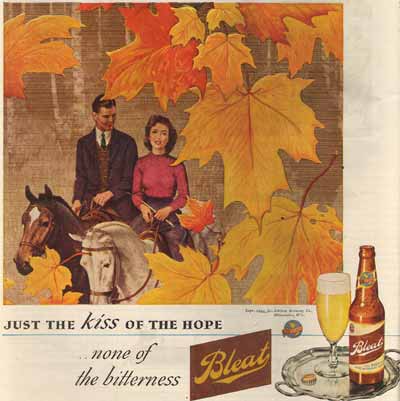 |
. |
 Ah, well. What to do. Well, I know what I have to do; I’m on call for Friday morning Playroom, which means that if someone calls in sick I have to tend a dozen strange kids for three hours, and I’m looking forward to that like I’m looking forward to flossing with a hacksaw and drinking a quart of pure lemon juice. This means I have to get my newspaper column out tonight. The good news, it’s written. The bad news: it needs more zip. Some pizzazz. And I am not in a pizzazz-bestowing mood. I hate to disappoint those who come here for the occasional screed, but right now it's a quarter to midnight, and I'm relaxed for the first time all day. Ah, well. What to do. Well, I know what I have to do; I’m on call for Friday morning Playroom, which means that if someone calls in sick I have to tend a dozen strange kids for three hours, and I’m looking forward to that like I’m looking forward to flossing with a hacksaw and drinking a quart of pure lemon juice. This means I have to get my newspaper column out tonight. The good news, it’s written. The bad news: it needs more zip. Some pizzazz. And I am not in a pizzazz-bestowing mood. I hate to disappoint those who come here for the occasional screed, but right now it's a quarter to midnight, and I'm relaxed for the first time all day.
Well, numb. I wrote a lot about this tonight, but it's late and I am tired of these things. Wait until Monday.
I decided to take some more pictures today, since I had the time – and since the photos give me something to write about besides the usual usual, which has not been a dependable source of inspiration this week. (No reason – I just get tired of certain topics, and when I do I expect you do as well.) I went to the West Bank, where I used to live. There are three communities around the University – Stadium Village, which has no real character or history; Dinkytown, which I photoblogged yesterday, and the West Bank, which has a played a potent role in local events. It was, and is, an immigrant community. In the 60s it was the Birkenstock Central, and that countercultural aroma hung around for decades after the thrills of the 60s wore off. The best burgers in town could be had at Annie’s Parlour; the Global Village store served all your crappy Third-World lacquered box / bamboo curtain / hemp soap needs. A bank anchored the corner of the main intersection, as is right and good and proper. There was even a False Valli - an attempt to repeat the Valli’s success on the West Bank, complete with giant stained-glass windows, a large pub and game room, the same menu. O how it failed.
I lived there because I thought it would be cool to live in a high-rise.
Well.
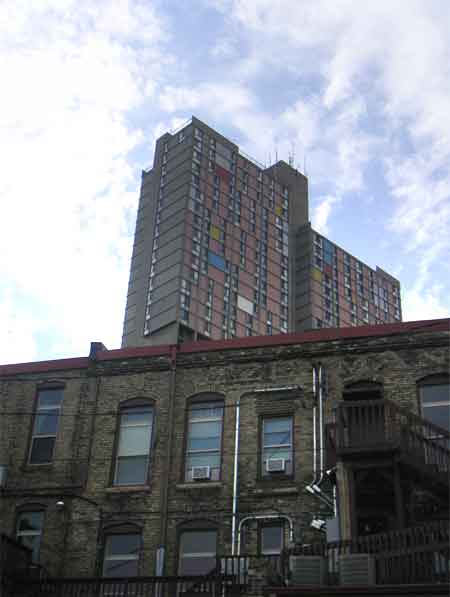
This is part Cedar Square West, a gigantic soul-consuming cement machine erected in the glory days of urban renewal. The project is 30 years old this year, and hence is receiving the glories we also give to old politicians and hookers. The structure above is the McKnight tower, one of several; it’s 39 stories tall. Guess how many elevators it had when it opened.
Three.
I lived in another building for a year; it wasn’t as tall, so the cockroaches had sufficient wind to reach my floor. It was a miserable year, but probably because I had a miserable apartment. I knew people who lived in other towers, and they had some swank spots. The complex has been given a prestigious award, and while you have to salute the audacity of the project - originally, they planned many more concrete soul-tombs, marching along the freeway, clawing the sky with dull grey fists - I wonder if the panelists who gave the award ever lived there. I remember February. Concrete plaza. Empty fountain. Wind. If razor blades had fallen from the sky, you'd have put your arms out wrists up.
Around the corner, an ancient firehouse from 1887. It’s now a theater. This hinge, I suspect, is original – and for that you can thank the freeway. When they gouged out great swaths of Minneapolis to build the highways, the West Bank was cut off from downtown. The road outside this station once traveled straight to the core of the city; now it bends around and wanders like an old man into half a dozen dead ends. If the street hadn’t been severed, this block might have been developed – but instead it simply rotted, this theater excepted.
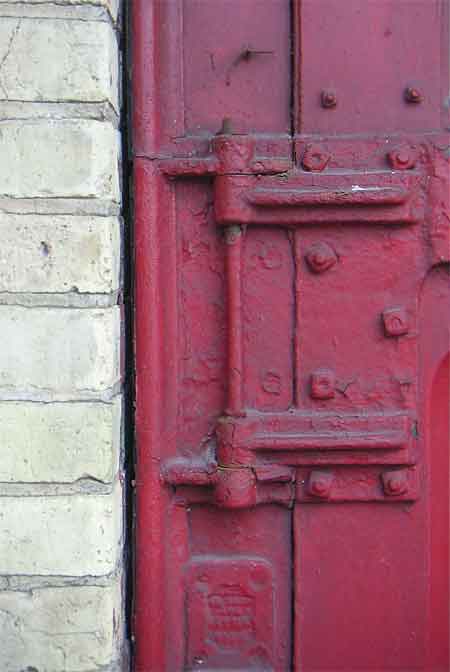
Through the marvel of Distort-O-Vision, I present two lunettes on the second floor. How did I get these straight-on shots? I jumped! As hard as I could!
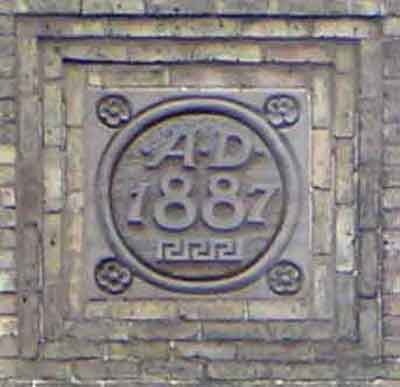
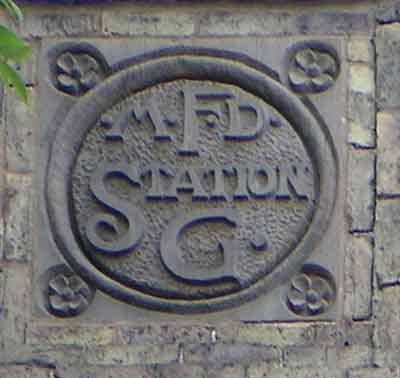
Two houses next to the firehouse are abandoned, and one has the classic Spook House appearance. Remember: this is half a block from Cedar Square West, the project that would revitalize the area.
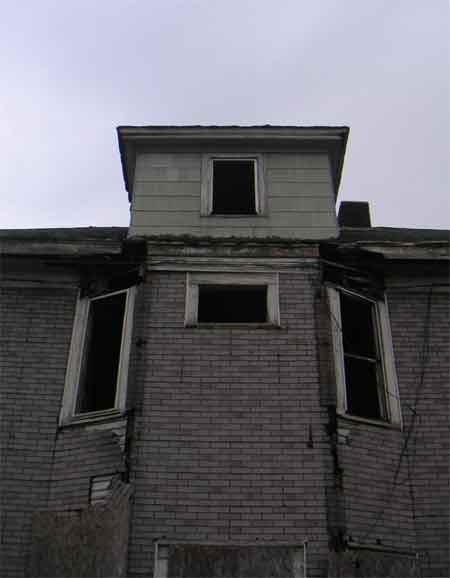
I wandered around the West Bank, which has changed a great deal since I lived there. The main bars still thrive, if that’s the word - they were the grimmest, darkest boozeholes I’ve ever known. The Palmer was for the AM drinkers; the 400 for the rock and rollers (it’s about 18’ X 18’ inside, it seems; on live music night you couldn’t play pinball without spearing 37 people in the ribs.) I went to the Viking once, and soon realized I would probably be beaten on general principle, and for good reason. I wouldn’t blame them. If I was the sort of person who went to the Viking I’d beat me too. The exterior has a classic Minnesota almost-ghost-ad:
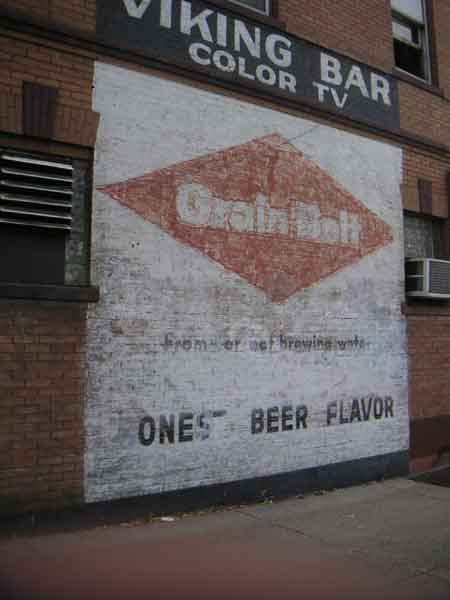
Honest beer flavor, for those who tire of sneaky prevaricating beers.
Political stickers? Sure. Feel the evil! Cower at the disembodied Zardoz-head of Ashcroft, hovering over head, its shadows making flowers wilt and shed their petals.
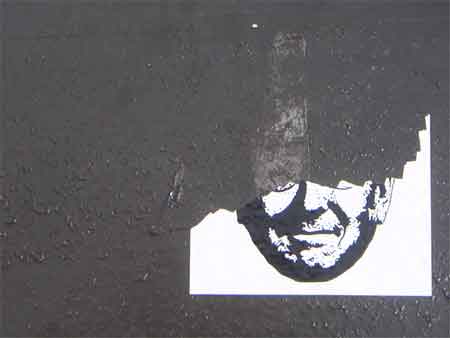
If someone was clever, they’d put a pipe in his mouth like Bob Dobbs. But again, “if someone was clever.” I was surprised to see very few stickers or anti-Bush graffiti; after all, the West Bank was the home to Minneapolis’ dope & granola culture in the 60s through the 80s. But now it’s mostly Somali. It looks cleaner and brighter and more sedate; it looks like it works for a living, and does not regard sitting around the coffeehouse arguing about Robert MacNamara as a way to spend one’s day. For that matter, the old West Bank spirit seems almost completely drained from the place. Savran’s bookstore: gone. Annie’s: gone. Caesar’s Pizza: deposed.
If I believed in ghosts I’d want to think the firehouse was full of them – big guys with ornate moustaches brushing ghost horses in the shade on a hot day, looking forward to a beer at the end of the shift, watching the traffic flow outside the station to the city at the end of the road. I don’t want to romanticize it – they had muddy streets and dead dogs in the gutter and boardwalks and dysentery and flu pandemics and high infant mortality rates and financial panics and winters that took the hindmost by the hundred.
But still.
I got in the car and drove over to East Hennepin, an old industrial street that’s unlovely and, well, industrial. It’s changing, slowly. The Dairy Queen was gone and knocked down, leaving only the sign:
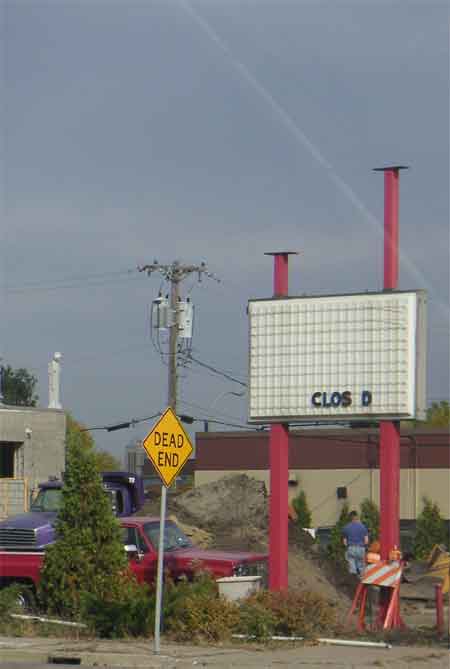
Sums it up. A few blocks away was a small office complex that was the original site of General Mills’ corporate HQ – or so a sign said. I peeked through an alley and caught sight of this amazing piece of vanished America:

You can just see the movie scene, can’t you? Eggheads in lab coats working on serums, with the help of Dr. Van Gelding from the Viennese Institute of Vienna. There’s a Pert young lab assistant who’s prone to speaking her mind.
“You’ll have to excuse my assistant, Dr. Van Gelding. She’s new.”
“No, I don’t mind at all, Tom. Tell me, miss - do you think the problem is biological, or molecular?”
“Well – if you’ll excuse me, Herr doctor, it’s neither. I - I read your paper on the effects of Geldenium, and I was very impressed, if you don’t mind me saying so.”
“Not at all, not at all.” Twinky eyes and a slight smile behind the white beard.
“Call it women’s intuition, but I think you should be looking for an elemental remedy.”
“You think Geldenium might provide the answer?”
“If we mix it with uranium and apply it as a paste, yes. I’m sure of it. As sure as I’ve ever been of anything.”
“Now, Joan-“
“I’m sorry, Tom, but I mean this. And there isn’t much time. Doctor?”
“The lady seems insistent, Tom. Shall we begin?”
And thus do they discover the cure for the Nazi’s Death Radio.
How could you walk through this door and not want to solve every problem on the planet?
|
|
|
|
|